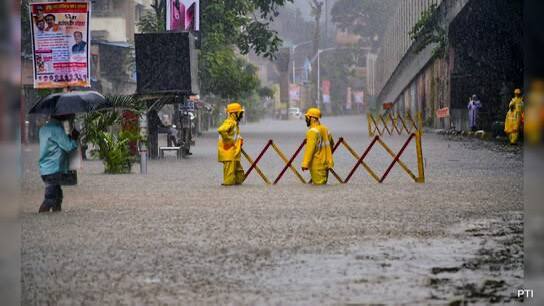Byline: Shubh Times News Desk | 19 August 2025
Summary: Torrential rains battered Mumbai and Maharashtra, claiming eight lives and disrupting daily life. Chief Minister Devendra Fadnavis has warned citizens that the next 48 hours are crucial, as the Indian Meteorological Department (IMD) issues a red alert for Maharashtra rain alert across multiple districts. Authorities are on high alert for any developments related to the Maharashtra rain alert.
Maharashtra Rain Alert: What to Expect
It’s essential for residents to stay updated on the Maharashtra rain alert to ensure their safety during this critical period.
Mumbai recorded nearly 300 mm of rainfall in 24 hours—equivalent to 37% of its monthly average. The city’s lifeline, local trains, slowed to a crawl as tracks were submerged, stranding thousands of commuters. Major roadways, including the Eastern Express Highway and Mumbai-Goa highway, were waterlogged, leading to severe traffic snarls.
Air travel also took a hit, with several flights delayed or cancelled. Passengers at Mumbai’s Chhatrapati Shivaji Maharaj International Airport faced hours of uncertainty as airlines battled schedule disruptions.
Rising Death Toll and Evacuations
So far, at least eight people have lost their lives due to incidents such as house collapses, electrocutions, and drowning. The NDRF and SDRF teams have been deployed extensively, rescuing over 2,500 people from flood-prone areas in Thane and Raigad.
Authorities have opened multiple relief camps in Raigad, Ratnagiri, and Palghar districts to provide shelter to stranded residents. Rescue boats and helicopters remain on standby, ensuring quick response if water levels rise further.
The government has emphasized the importance of adhering to the Maharashtra rain alert guidelines issued by authorities.
As the situation evolves, updates on the Maharashtra rain alert will be crucial for residents in affected areas.
Emergency services are on standby, ready to respond to the challenges posed by the Maharashtra rain alert.
Local authorities encourage residents to familiarize themselves with the Maharashtra rain alert protocols.
CM’s Appeal to Citizens
Businesses are advised to monitor the Maharashtra rain alert closely to prepare for possible disruptions.
Chief Minister Devendra Fadnavis chaired a high-level meeting to review the situation. In a public statement, he urged citizens: “The next 48 hours are crucial. Please remain indoors as far as possible and avoid unnecessary travel.”
The IMD will provide updates regarding the Maharashtra rain alert as the weather situation develops.
Residents are advised to heed the Maharashtra rain alert as it may affect daily routines and safety.
He also directed all disaster management agencies to coordinate closely with local administrations and maintain round-the-clock alertness. Control rooms have been set up across districts to handle emergency calls and provide real-time assistance.
Transport and Infrastructure Impact
Keeping informed about the Maharashtra rain alert will be vital for making safe travel decisions in the coming days.
Beyond flights and trains, Mumbai’s Brihanmumbai Electric Supply and Transport (BEST) buses were forced to reroute several services due to waterlogging. Power cuts were reported in parts of Navi Mumbai and suburban Thane as a precautionary measure.
The disruption also raised concerns for businesses and daily wage workers, many of whom could not reach their workplaces. Economic experts warn that if the rain intensity persists, it could cause significant short-term financial losses for the state.
IMD Weather Forecast and Climate Warning
The IMD attributed the heavy downpour to a low-pressure area over the Arabian Sea that has intensified into a depression. Meteorologists have issued a red alert for Konkan, Goa, and central Maharashtra, warning of extremely heavy rainfall over the next two days.
Water levels in major dams such as Bhatsa and Vaitarna are rising rapidly, prompting authorities to prepare for controlled water releases. Experts also pointed out that Maharashtra has seen increasingly erratic monsoon patterns in recent years, linking the trend to broader climate change effects.
Historical Context: Mumbai’s Battle with Rains
This year’s flooding once again brings back memories of 2005 Mumbai floods, when nearly 944 mm of rainfall in a single day paralyzed the city. Although infrastructure improvements have been made since, the recurring issue of waterlogging highlights gaps in drainage and urban planning that need urgent long-term solutions.
Maharashtra is bracing for a tense 48 hours as the rains continue. With eight lives lost, thousands displaced, and infrastructure strained, the state’s preparedness is being put to the test. The government has urged citizens to stay indoors, avoid flooded zones, and rely only on official advisories for updates.
As relief and rescue operations continue in full swing, the focus remains on saving lives, restoring normalcy, and mitigating damage. The unfolding situation will be closely watched across the country as Maharashtra battles one of its most severe monsoon spells in recent memory.


